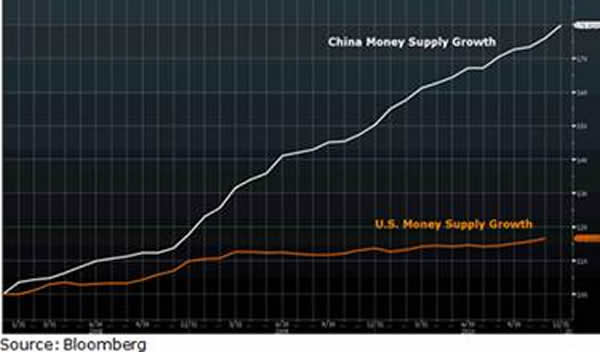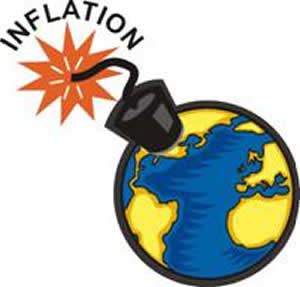China, Inflation and Gold, China created paper money and paper money then created Inflation
Economics / Inflation Feb 09, 2011 - 04:23 AM GMTBy: Darryl_R_Schoon
 Ralph T. Foster in his invaluable book, Fiat Paper Money, The History and Evolution of Our Currency, writes that paper money made its first appearance in Szechwan, a remote province of China early in the 11th century.
Ralph T. Foster in his invaluable book, Fiat Paper Money, The History and Evolution of Our Currency, writes that paper money made its first appearance in Szechwan, a remote province of China early in the 11th century.
Because of a shortage of copper coins, provincial officials had begun circulating iron coins; but the difference in value and weight between the two metals caused unexpected problems.
As Foster writes: [housewives needed] one and one-half pounds of iron [coins] to buy one pound of salt…Paper was the answer. People began to deposit their iron money in money shops and exchanged deposit receipts to transact business.
The money shops’ deposit receipts then began circulating as money. But the money shops soon issued more deposit receipts than their supply of coins and by 1022, confidence had eroded in both the notes and the supporting iron money [and] government authorities closed the private note shops.
When the Chinese government intervened, the government quickly discovered the advantages paper money—at least to the issuers. The Sung dynasty immediately banned the issuance of paper notes by private money shops and on January 12, 1024, the Sung court directed the imperial treasury to issue national paper money for general use.
In the beginning, the imperial treasury backed its paper notes with cash coins equal to 29% of the paper money issued. Eventually, however, the Sung, like each succeeding dynasty, would print far more money than it actually possessed in backing.
The consequent loss of confidence in paper money caused Chinese scholars to question the nature of money...Ye Shi (1150-1223) spoke out against excessive amounts of what he called “empty money” when he observed how paper inflation hurt the economy; and scholar Hu Zhiyu (1127-1295) concluded that only backing gave paper value and blamed the retreat from convertibility for the loss of public confidence.. paper money, the child, is dependent on precious metals, the mother. Inconvertible notes are therefore “orphans who lost their mother in childbirth”. (page 19)
For the next 600 years, succeeding dynasties would each attempt to utilize the advantages of paper money and avoid its disadvantages. Not one dynasty was able to do so. All attempts to use paper money ended in runaway inflation and dynastic collapse.
By 1661, China finally learned its lesson and the new Qing dynasty officially outlawed paper money. Regarding China’s 600 year experiment, Foster writes:
Over the course of 600 years, five dynasties had implemented paper money and all five made frequent use of the printing press to solve problems. Economic catastrophe and political chaos inevitably followed. Time and again, officials looked to paper money for instant liquidity and the immediate transfer of wealth. But its ostensible virtues could not withstand its tragic legacy: those who held it as a store of value found that in time all they held were worthless pieces of paper. (page 29)
Today, almost 1,000 years after paper money first appeared and 350 years after China banned its use, China’s is again issuing excessive amounts of paper money; and, once again, paper money’s initial prosperity is about to give way to inflation and economic chaos in the celestial kingdom.
Southern Weekly, a Chinese language publication, recently noted: China has not only been the country that prints money at the fastest rate but also been the country with the largest money supply in the world in the past decade. China’s M2, a broad measure of money supply, was up 19.46% at the end of November from a year earlier...This compares with 3.3% and 2.5% of annual M2 growth in the US and Japan respectively over the same period…

China's money supply, M2-to-GDP ratio over the past decade is the highest in the world. The nation with the longest history of excessive money printing and consequent inflation has clearly forgotten its past. The past, however, has not forgotten China.
2011: CHINA, INFLATION & THE PRICE OF GOLD
Asian nations, China and India in particular, have a long history with gold. Precious metals as a hedge against chaos is deeply embedded in Asian cultures and when chaos takes the form of inflation, gold is the default hedge; and, today, inflation is on the rise.
China raised interest rates for the third time since mid-October ahead of a report forecast to show inflation accelerated to the fastest pace in 30 months.
February 8, 2011, Bloomberg News
This has profound implications for the price of gold. As inflation continues to increase, the buying of physical gold by the Chinese will send the price of gold skyrocketing. In fact, it has already begun.
On February 2nd, the Financial Times reported: Fears of inflation have also driven demand for gold as a retail investment… Precious metals traders in London and Hong Kong said on Wednesday they were stunned by the strength of Chinese buying in the past month. “The demand is unbelievable. The size of the orders is enormous,” said one senior banker, who estimated that China had imported about 200 tonnes in three months.
On February 8th, Karen Maley in Australia’s Business Spectator discussed this growing phenomenon in her article, China’s gold tsunami: It’s not hard to understand the growing Chinese enthusiasm for gold. Officially, China’s inflation rate was 4.6 per cent in December, but many believe the actual inflation rate is considerably higher. But Chinese savers earn a paltry interest rate of 2.75 per cent on one-year deposits, which means that they face negative real interest rates.
Faced with these dismal returns, Chinese households and businesses have been pouring money into physical assets, such as food, real estate, and commodities as a hedge against inflation. Chinese authorities are now trying to quell property market speculation by making it more difficult for buyers to get bank finance for their second and third investment properties, and have begun experimenting with property taxes in some cities.
This has caused Chinese investors to turn to gold. According to the Sprott newsletter, China, which is already the world’s largest gold producer, imported more than 209 metric tons of gold in the first ten months of 2010 alone. This compares with the estimated 45 metric tons it imported in all of 2009.
DON’T WORRY ABOUT 2012
2011 IS HERE
The response to the 2008 global collapse set in motion an even greater danger—runaway inflation. In 2009 world governments attempted to offset the global collapse in demand with historic levels of liquidity. The excessive printing of money has now led to higher prices.
Prices, especially food prices are rapidly rising. Tyler Durden, www.zerohedge.com, makes this point with stunning clarity: One of the benefits of America finally seeing what Zimbabwe went through as it entered hyperinflation, ignoring for a second that the Zimbabwe stock market was the best performing market, putting Bernanke's liquidity pump to shame, is that very soon everyone will be naked, once companies finally realize they have no choice but to pass through surging input costs. And while some may be ecstatic by the S&P's modest rise YTD, it is nothing compared to what virtually every single agricultural product has done in the first month of 2011. To wit: Corn spot up 7.76%, wheat up 5.63%, Rice up 10.08%, Hogs up 10.16%, Sugar up 5.64%, Orange Juice up 3.33%, and cotton.... up 17.08%. That's in one month!

Rapidly rising food prices have already contributed to governments falling in Tunisia and Egypt. Other governments, well aware of the risk that inflationary food prices pose to their continued rule, are now stockpiling food to prevent further protests.
This buying will only drive the cost of food even higher: Jim Gerlach, of commodity brokerage A/C Trading, said: "Sovereign nations are beginning to stockpile food to prevent unrest." "You artificially stimulate much higher demand when nations start to increase stockpiles."
"This is only the start of the panic buying," said Ker Chung Yang, commodities analyst at Singapore-based Phillip Futures. "I expect we'll have more countries coming in and buying grain.
http://www.telegraph.co.uk/...
INFLATION & THE FUTURE PRICE OF GOLD
Even the hardened paper boys on Wall Street are aware of inflation’s impact on the price of gold. The meteoric rise of gold in the late 1970s was caused by rapidly rising prices. In the last decade, however, gold began moving steadily higher as did all commodities in a disinflationary atmosphere. That, however, is about to change.
With gold already moving higher, the increasing inflationary impetus will send the price of gold far beyond its present price. Gold’s spectacular ascent in the 1970s is now about to be dwarfed.
Last night, I, Ralph T. Foster, our wives and another couple had dinner together and the topic turned to the future price of gold. There was agreement that while its ascent was certain, gold’s ultimate price was a matter of pure conjecture since the reference points used to value that price would be virtually worthless pieces of paper money.
History is the context within which our present circumstances present themselves. Of late, change has been so rapid that many believe the past is merely that which preceded the present. They are wrong.
History is about to repeat itself, albeit in a new iteration. Paper money’s journey to the west and back again is about to reach its fatal climax. Paper money’s ten-century drama is almost over; and while a new and better era will replace it, the collapse of the present era will be unprecedented in magnitude.
Ralph T. Foster’s Fiat Paper Money, The History and Evolution of Our Currency, can be ordered at http://home.pacbell.net/tfdf/ . My latest local TV show, Dollars & Sense, can be viewed at http://www.youtube.com/user/SchoonWorks#p/a/u/0/0JB4_lFwi4c
Buy gold, buy silver, have faith.
By Darryl Robert Schoon
www.survivethecrisis.com
www.drschoon.com
blog www.posdev.net
About Darryl Robert Schoon
In college, I majored in political science with a focus on East Asia (B.A. University of California at Davis, 1966). My in-depth study of economics did not occur until much later.
In the 1990s, I became curious about the Great Depression and in the course of my study, I realized that most of my preconceptions about money and the economy were just that - preconceptions. I, like most others, did not really understand the nature of money and the economy. Now, I have some insights and answers about these critical matters.
In October 2005, Marshall Thurber, a close friend from law school convened The Positive Deviant Network (the PDN), a group of individuals whom Marshall believed to be "out-of-the-box" thinkers and I was asked to join. The PDN became a major catalyst in my writings on economic issues.
When I discovered others in the PDN shared my concerns about the US economy, I began writing down my thoughts. In March 2007 I presented my findings to the Positive Deviant Network in the form of an in-depth 148- page analysis, " How to Survive the Crisis and Prosper In The Process. "
The reception to my presentation, though controversial, generated a significant amount of interest; and in May 2007, "How To Survive The Crisis And Prosper In The Process" was made available at www.survivethecrisis.com and I began writing articles on economic issues.
The interest in the book and my writings has been gratifying. During its first two months, www.survivethecrisis.com was accessed by over 10,000 viewers from 93 countries. Clearly, we had struck a chord and www.drschoon.com , has been created to address this interest.
Darryl R Schoon Archive |
© 2005-2022 http://www.MarketOracle.co.uk - The Market Oracle is a FREE Daily Financial Markets Analysis & Forecasting online publication.



